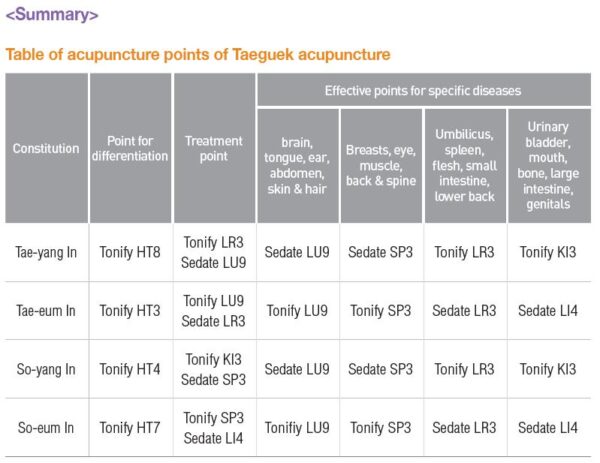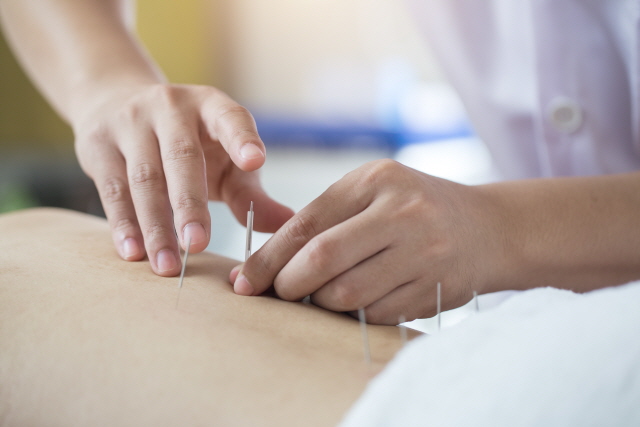- Sanghoon Lee, KMD, MPH, PhD, DiplAc, LAc Professor, Department of Acupuncture and Moxibustion, College of Korean Medicine Kyunghee university
- Dongwoo Nam, KMD, PhD Assistant Professor, Department of Acupuncture and Moxibustion, College of Korean Medicine Kyunghee university
- Jeongmin Ko, KMD, Dr.Jeongmin Ko’s Korean Medicine Clinic (Inc.) All that Korean Medicine
- Hyojung Kwon, KMD, PhD (Inc.) All that Korean Medicine
- Seung Min Kathy Lee, KMD, PhD, Research Fellow Department of Acupuncture and Moxibustion, College of Korean Medicine Kyung Hee University
- Park Jun Hyeong, KMD, MS, Researcher, Department of Acupuncture and Moxibustion, College of Korean Medicine Kyung Hee University
Published in December 2017 by Korean Society of Acupuncture & Moxibustion Society
Saam acupuncture and Sasang constitutional medicine are unique traditional Korean medicines. Taegeuk acupuncture is the acupuncture method on the basis of Sasang constitutional medicine. Having evolved from traditional Chinese medicine—in
fact, the far Eastern traditional medicine in general, for the Confucian and Taoist civilization has been established over the centuries in the whole far Eastern Asian region—traditional Korean medicine has developed typical medical theories by renowned medical scholars.
Sasang constitutional medicine was founded by Lee Je-Ma. It classifies a person into one of four types by the relative size of the Organs. They are namely Tae-yang (Greater Yang), Tae-eum (Greater Yin), So-yang (Lesser Yang), and So-eum (Lesser Yin). A person is determined as the “In (person),” such as Tae-yang In, Tae-eum In, So-yang In, and So-eum In. The four constitutions are different from the taiyang, taiyin, shaoyang, and shaoyin in the theory of the six meridian diagnosis that includes yangming and jueyin as well.
According to the Sasang constitutional theory by Lee Je-Ma, an aggravated energy discrepancy among the four major Organs is the cause of various diseases, the imbalance resulting in superficial pathologic conditions. The four major Organs are Lung, Spleen, Liver, and Kidney. The Heart is the “Central Ultimate,” thus the acupuncture theory called Taegeuk acupuncture.
Lee Je-Ma prescribed different herbal medicine for patients with apparently similar diseases, based on their respective constitutions. Rather than dealing with numerous diseases, the practitioner can deliver four simple types of treatment for a diverse range of illnesses, aimed at recovering the energy balance of the constitution. Lee Je-Ma’s original system of Sasang constitutional medicine lacked the acupuncture treatment, and Lee Je-Ma left the task behind for the acupuncture system of Sasang constitutional medicine to be developed by the future generation.
Lee Je-Ma’s words were, “A doctor needled LI4 of a So-eum In patient complaining of dysarthria from the sequelae of stroke. The effect was astonishing that there may be other diseases that are better cured by acupuncture than herbal medicine. Acupuncture points may be applied to the four constitutions as well, therefore further study is called for in the future.”
As a response to this testament Lee Byeong-Haeng established Taegeuk acupuncture theory. LI4 is the source point of the Large Intestine meridian. It is used to sedate what is excess in So-eum In. The source point of the Large Intestine meridian is used instead of that of the Kidney meridian, because in the principle of Sasang constitutional medicine, the Kidney should not be sedated, and theoretically be substituted to Large Intestine.
The constitution is determined prior to treatment, and then the source point of the relevant Organ is tonified or sedated. Lee Byeong-Haeng also suggested that observing the reaction to the needle stimulation of acupuncture points on the HT meridian can be helpful in the classification of the constitution, because the Heart energy plays a central role in controlling other Organs in the Sasang constitutional medicine system.
Taegeuk acupuncture is a curing system in which the patient gets over his or her own disease on his or her own by compensating for the loss of balance of the Organs. Tae-yang In is in the state of Metal excess, and the constitutional characteristics of Taeyang In come from the discrepancy between the large Lung and small Liver energy. This Metal excess state is regulated by stimulating Fire factor in Taegeuk acupuncture. On the contrary, Tae-eum In is in a state of Wood excess. Therefore the discrepancy between the large Liver and small Lung energy constitutes the characteristics of Tae-eum In. Tae-eum In’s Wood excess state is related by stimulating the Metal factor. The same logic is applied to Fire-excess So-yang In and Water-excess So-eum In, who have large Spleen and small Kidney, or vice versa.
HT8, HT4, HT3, and HT7 are the acupuncture points on the Heart meridian with the characteristics of Fire, Metal, Water, and Earth. They are tonified to control the original dominant Organs of Tae-yang In, Tae-eum In, So-yang In, and So-eum In respectively.
The source point of the meridian of the corresponding constitution’s large organ is sedated and that of the small organ is tonified. Therefore, since Tae-yang In has large Lung and small Liver, the source point of Liver meridian, namely LR3, is tonified, and the source point of Lung meridian, LU9, is sedated. It works the other way for Tae-eum In who has small Lung and large Liver, contrary to Tae-yang In. LU9 is tonified and LR3 is sedated. In that sense, SP3, the source point of the Spleen meridian, is sedated and KI3, the source point of the Kidney meridian, is tonified. Vice versa would work for So-eum In, except that KI3 is substituted by LI4 for the reason mentioned previously.


































